Fred Sandback / Fred Sandback and Annemarie Verna Gallery. A Collaboration 1971 to 2003.
Fred Sandback lived from 1943 to 2003. An initial exhibition of three important sculptures by the artist took place in our gallery space in 1971, which was then located on Obere Zäune in Zurich.
In 1972, we visited Fred in New York. He lived and worked in a simple loft on Crosby Street in SoHo. This neighborhood was viewed as dangerous and run-down, as an industrial slum. Nevertheless, the late 1960s saw many artists move to SoHo. In previous years, many small-scale industrial enterprises in this part of Manhattan had been forced to close, leaving numerous five- or six-story buildings vacant. Artists formed cooperatives to jointly purchase these properties and divide them up level-by-level, which made ownership of an entire floor affordable. With minimal effort, the former manufacturing facilities were transformed into studios and in some cases also used as housing, which officially remained illegal up until 1973. In most cases, the renovations were limited to a coat of white wall paint and a few minor structural interventions. It was important to the artists to have as much space as possible in these lofts.
In 1968, Paula Cooper opened her gallery in SoHo and in the years after 1970, a relatively small but important gallery scene took shape. The spacious interiors of the galleries, which initially established themselves on West Broadway and some of the neighboring streets, would later mutate into the famous ‘White Cube’.
The factors that allowed such a dense and internationally unique art scene to develop and unfold here were related to a constellation of economic preconditions and exceptional circumstances and possibilities, especially concerning the procurement and use of expansive working and living space
The fact that the given space often became a working material for the new art and the relation of the artifacts to the exhibition space established itself as a guiding principle is actually obvious and apparent. The availability of ample space essentially engendered a new definition of the art object and a new exhibition aesthetic. This was far more than a new form of art production and presentation. ‘Space’ acquired an almost magical connotation and particular importance was placed on the correspondence of the works to the exhibition situation. The exhibition was granted more and more intrinsic value and the consequences of these shifts in significance are still in evidence today. In addition, innovation from then on became a prerequisite of any serious artistic achievement.
Even before our trip, we knew the names and the work of the important protagonists in the scene and had already shown works by some of these artists in the gallery. Yet viewing it up close and in person was different and more direct, infused with an incomparable atmosphere and air of adventure. The value accorded to the physical space proved particularly impressive. We were then faced with the question of how we could attain a valid presentation and mediation of this new art with the limited space and modest economic possibilities available to us.
In 1972, Fred Sandback was just under thirty years and he was an artist of our generation. The invention that constituted the foundation of his work, his working method and his artistic approach were paradigmatic of the kind of art that interested us. It was precisely how we imagined the orientation of our gallery. Our visit was the beginning of a lifelong friendship.
The translation of our New York experience to our own possibilities was afforded by Fred’s artistic vision in an ideal and convincing form. A fusion of space and object as Fred was able to realize did not thematically address the sheer size, the volume of a space, but rather the singularities and particular characteristics of the found spatial framework. In a delicate balance and dialogue with the given situation, he constructed his sculptures and the actual architectural conditions became an essential sculptural element of the works.
In December 1972, Fred came to Zurich and installed a brilliant exhibition in the gallery. The fact that some gallery visitors believed the exhibition space was empty and still in the preparation phase filled us with pride. This was in fact an indication of the show’s complete and utter success and a reminder to art enthusiasts of the need to activate their powers of perception. Over the following three decades, four different locations of the gallery showed themselves time and again to be suitable places for new sculptures and the transformation of our spaces became a true event.
For our retrospective, we have been able to assemble a number of drawings associated with the exhibitions of Fred Sandback in the respective gallery spaces. Delicate isometric renderings show the particularity of the real gallery space. It becomes clear that the plastic volume of the architectural housing determines the positioning and the selection of the potential formal elements of the boldly drawn sculptures.
When staging his exhibitions, it should be noted that Fred seldom constructed his sculptures based on preexisting drawings. Only after entering and experiencing the respective premises would his interventions become an artistic achievement, one made in the here and now. The architectural conditions of the place became the point of departure for all decisions. In a lengthy, almost meditative process he defined all the elements of the sculpture and the surrounding space, with its material forms being employed by the artist as one of his tools. Two early sculptures are part of the present show.
Installation views

Sol LeWitt
Wall Drawing (WD 1180)
10’000 black straight lines and 10’000 black not straight lines
in progression for the next exhibition.
(Drawn by Nicolai Angelov)
Opening: May 15th, 2015

Installation view room 4

Installation view office room
© Photos: Thomas Cugini

Installation view office room

Installation view office room

Installation view office room

Installation view office room

Installation view office room

Installation view

Installation view
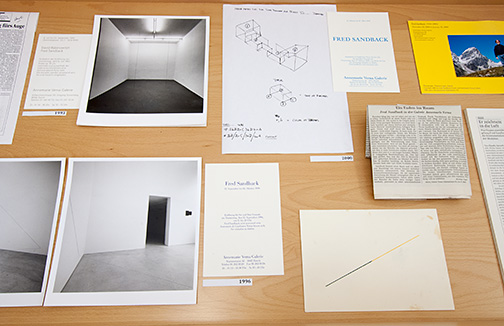
Installation view

Installation view

Installation view

Installation view room 1
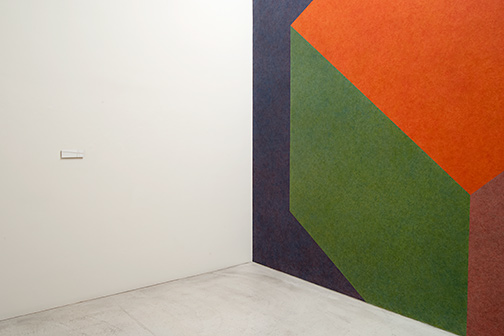
Installation view room 1

Installation view room 1

Installation view room 2

Installation view room 2
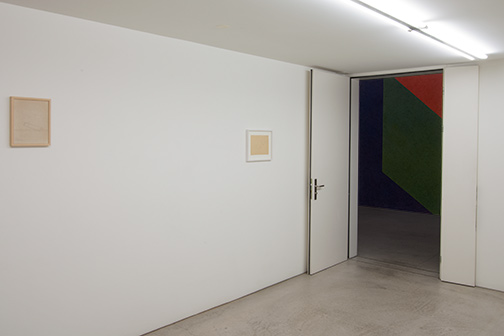
Installation view room 2

Installation view room 3
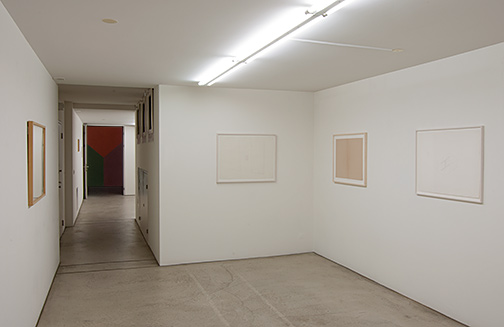
Installation view room 3

Installation view room 3

Installation view room 4

Installation view room 4

Installation view room 4
Works

Untitled
21 x 29 cm
pencil and color crayon on paper

Untitled
2000
21.6 x 27.9 cm
pastel pencil and pencil on yellow paper
Annemarie Verna Gallery
Neptunstrasse 42

Untitled
1998
7.8 x 20.8 x 1.5 cm
acrylic on wood

Untitled
1988
56.5 x 76.5 cm
pastel on paper
Annemarie Verna Gallery
Scheuchzerstrasse 35

Untitled
1967
25.7 x 23.5 x 312.4 cm
elastic cord and steel rod Brittany Blue
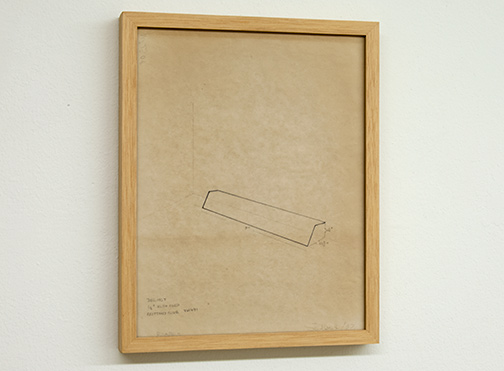
Untitled
1/8 inches RCD + Cord Brittany Blue
1967
27.8 x 21.7 cm
pencil on tracing paper

Installation Gallery Heiner Friedrich Munich
1968
19.5 x 26.7 cm
pencil and colored pencil on paper

Untitled
1981
56.5 x 76 cm
pencil and black and red crayon on paper

Untitled
1981
50 x 65 cm
pencil and colored crayon on cream paper
Annemarie Verna Gallery
Mühlegasse 27

Untitled
1976
56 x 76.4 cm
pencil and ink on paper
Annemarie Verna Galerie
Mühlegasse 27

Construction with 4 Vertical Elements for Annemarie Verna Zürich
1976
56 x 76.5 cm
pencil and ink on paper
Annemarie Verna Gallery
Mühlegasse 27

Two Aspects of a Two-Part Construction for the Annemarie Verna Gallery, Zürich
1976
76.5 x 57.5 cm
pencil and colored chalk on paper
Annemarie Verna Gallery
Mühlegasse 27
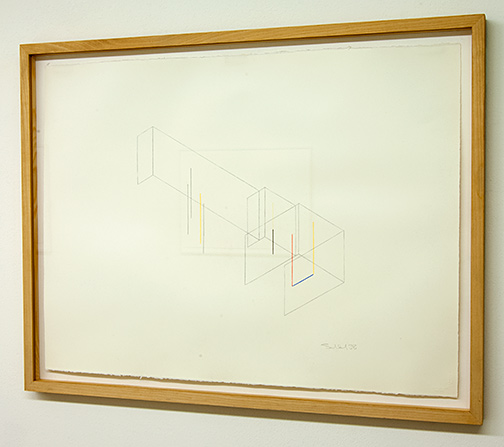
Untitled
1988
56 x 76 cm
colored crayon on paper
Annemarie Verna Gallery
Scheuchzerstrasse 35

Untitled
1966 / 1976
22 x 28 cm
blueprint

Untitled
1968
203.2 x 274.3 cm
orange elastic cord

The First of 256 Constructions of Four Diagonal Lines
1970 / 2000
43 x 55.8 cm
pencil and black ink on paper
Annemarie Verna Galerie
Neptunstrasse 42

Sol LeWitt
Tilted Form with color ink washes superimposed
1987
Wall Drawing #524
Drawn by Nicolai Angelov
Photo: Thomas Cugini, Zürich
New
Exhibition
Dan Flavin (1933–1996) and Will Insley (1929–2011)
March 6 to April 26, 2024
New publications
James Bishop
James Bishop
Publisher: ER Publishing, Edited by Molly Warnock
Joseph Egan
Joseph Egan and Anton Himstedt: Common Ground
Publisher: Josef Albers Museum Quadrat Bottrop, Ulrike Growe
Exhibitions / Insight
INSIGHT #3 spotlights the graphic work of Fred Sandback through three examples from 1974 and 1982.
Joseph Egan, Ptolemäus: Die Welt im Griff? Antike Kartographie und zeitgenössische Kunst, Kunsthaus Grenchen
3. März bis 26. Mai 2024
Dan Flavin, Widmungen aus Licht, Kunstmuseum Basel
2. März bis 18. August 2024
Rita McBride, Momentum,
Dia Beacon, Beacon, NY,
July 1, 2023 to January 2025
Fred Sandback, Kurt Büsser ermöglicht... Erich Buchholz und Fred Sandback, Museum Wiesbaden
19. Januar bis 14. April 2024
Sol LeWitt (1928–2007)
A Wall Drawing Retrospective
Yale University Art Gallery and Williams College Museum of Art
November 16, 2008 – 2033

